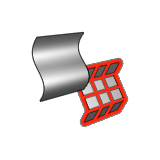NURBS to Poly
Convert NURBS surfaces into polymeshes. You can save the polymesh as a STL file and send it directly to a 3D printer.
- On the ribbon, click the PolyNURBS tab.
-
Click the NURBS to Poly icon.

-
Select one or more NURBS surface objects.
The surfaces of the selected objects are now part of an ungrouped output object.
- In the Control Panel, you can change the Name of ungrouped output object.
-
To divide the output object into groups:
- In the guide bar, click Add Group.
- Select one or more surfaces. The surfaces are added to the new group and no longer part of the ungrouped output object.
- Assign a group name in the Control Panel.
-
To edit a group:
To Do this Rename a group - In the Control Panel, select the group in the list.
- Enter the Name of Current Group.
Change a group's color - In the Control Panel, select the group in the list.
- Click the Color of Current Group.
- Select a color.
Delete a surface in the group - In the guide bar, next to Current Group
Surfaces, click
 .
. - A list of the surfaces in the group is displayed.
Select the surface to delete and click
Delete selected entities
 .
.
Delete a group - In the Control Panel, select the group.
- Click
 .
.The faces in the group will be moved back to the ungrouped output object.
-
To adjust the tessellation, configure the following options in the Control
Panel:
Option Description Triangles Only Perform a tessellation using triangular facets. Triangular polymeshes are characterized by their simplicity and flexibility; the triangle is the only polygon whose vertices are guaranteed to be coplanar. Tolerance on Curves Adjust tessellation along the edges of a polymesh object.
Chordal: Defines the maximum distance between a curve segment on the original NURBS surface and its subtended chord on the resulting tessellated polymesh surface.
Max Length: Define the maximum length of a polygonal edge.
Angular: Define the maximum angle between two adjacent polygonal edges.
Tolerance on Surfaces Adjust tessellation on the surfaces of a polymesh object.
Surface: Define the maximum distance between a curve segment on the original NURBS surface and its subtended chord on the resulting tessellated polymesh surface.
Angular: Define the maximum angle between two adjacent polygonal faces.
Face Dimension Modify the size of each face in the polymesh.
Min: Define the minimum dimension of each face in the polymesh.
Max: Define the maximum dimension of each face in the polymesh.
Sew Tolerance Define the maximum gap that can exist between two adjacent faces in order for them to be considered coincident along the edge. Edge Smoothing Disable edge smoothing to allow for accurate visualization of the model for 3D printing. - Right-click and mouse through the check mark to exit, or double-right-click.